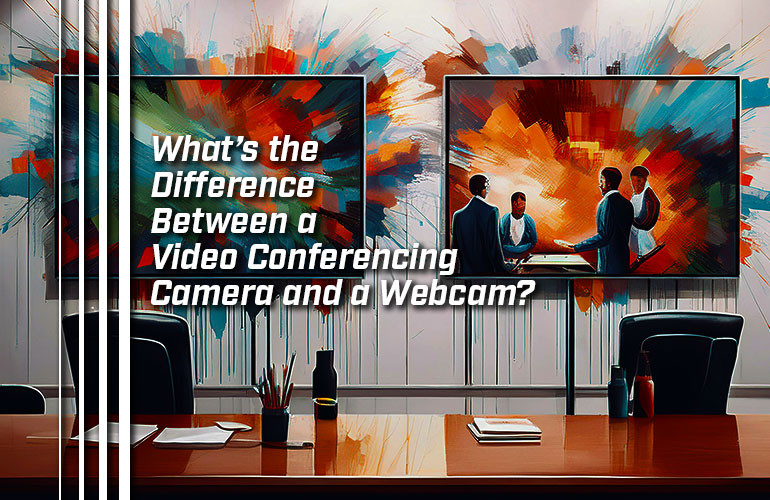When it comes to professional video conferencing, the camera in your laptop or tablet or smartphone ain’t gonna cut it.
During the pandemic, many businesses adopted video conferencing for the first time. And many of these businesses bought a webcam for their conference room, because they get the job done and they’re not too expensive. But there’s something nagging. The video quality isn’t what you’d hoped.
Is your business one of these? We recently covered how your business communications ecosystem can say a lot about your business and how important it is to look professional: “What Does Your Video Conferencing System Say About Your Business?”
In this blog, we explore the difference between a professional Video Conferencing Camera and a Webcam. We also touch upon video bars, which integrate video conferencing cameras with a speaker and microphone — and often a codec for running the meeting software, too — in an all-in-one solution.
For more on video conferencing in general, check out our clear, detailed Video Conferencing Buyer’s Guide.
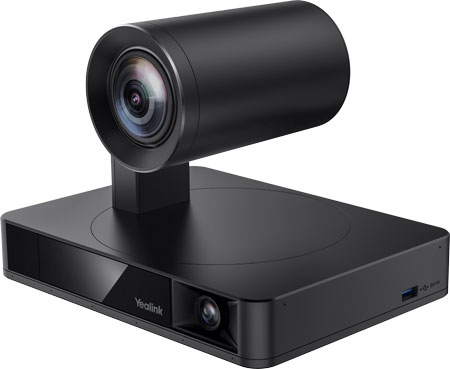
Webcam vs Camera for Video Conferencing
There’s no difference between a video conferencing camera and a webcam, strictly speaking. Both are video cameras that take video while attached to a computer — which might be a laptop, PC, smartphone, tablet, network switch, etc.
That said, companies often use the two terms to differentiate between intended use-cases. So when you’re shopping for a video camera for video conferencing, you need to know what each term signifies: webcam and video conferencing camera. Here’s an overview of what each term means in general:
Webcams are video cameras intended for personal use on video calls or for self-recording (e.g., for a YouTube video). They might be used with small groups of people in a focus room, but they’re mostly intended to be used for one person. Webcams are compact, plug-and-play cameras, often mounted on top of computer displays. They tend to have lenses that are geared to making a single face look good, rather than capturing a whole group of people.
Video conferencing cameras, on the other hand, are cameras intended for group use on professional video calls. They’re quite diverse, with models that work with small groups in huddle rooms to groups dozens of people big in extra-large conference rooms. They might have a wide-angle lens to help capture whole groups of people or pan-tilt-zoom (PTZ) functionality for capturing individual faces. PTZ also lets you angle and zoom in to help you get the most effective shot without moving the camera around.
You’ll find options for both webcams and video conferencing cameras that will take 4K Ultra HD video or better — even though your video conferencing platform will probably only support up to 1080p Full HD video calls right now! Good to be futureproofed, though. If video resolution isn’t a difference maker, what is?
What you want to do is get the right camera for the size of the video conferencing space and the number of meeting participants.
Our rule of thumb? For personal video conferencing and for very small groups in focus rooms, a webcam will be just fine. But for video conferencing with groups of more than a few people, you should look for a video conferencing camera or video bar.
Why? Let’s cover these differences in more detail:
- Advanced Camera Technologies
- Field of View
- Optical Zoom vs Digital Zoom
- Multi-Camera Setups
At the end, we cover video bars.
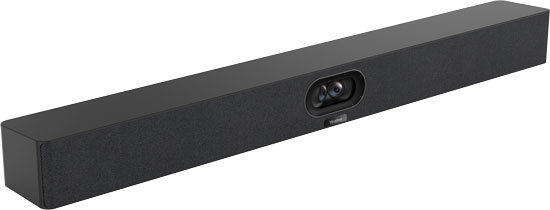
Video Conferencing Cameras Offer Advanced Camera Technologies
While webcams will likely have image-enhancing technologies — like backlight compensation, which sets the image brightness levels to faces rather than windows or lights, or automatic white balance, which adjusts the picture color to make people’s skin tones look natural — they often lack certain meeting-enhancing features that true video conferencing cameras offer.
Many video conferencing cameras now offer automatic group framing, speaker tracking, presenter tracking, and similar. These intelligent features offer an experience in the conference room like you have a director controlling the video feed — but without you needing to do anything.
Group framing technology analyzes the picture to determine which shapes are people. Then it focuses the picture so that the group is framed effectively: not a bunch of wasted space on the edges but not so tightly framed that it looks bad.
Speaker tracking technology uses beamforming microphone arrays to determine the location of an active speaker. Then it focuses on that speaker. When someone else starts talking, it switches to the new speaker. Often, the camera will combine the group framing and speaker tracking: when someone in talking, it frames the speaker, and when no one is talking, it shows the whole group.
Presenter tracking can be thought of as dynamic speaker tracking. As the presenter speaks and moves around, the beamforming microphone array determines their location. The camera then focuses on the presenter, adjusting the camera as the presenter moves.
There are also cameras that offer multiple feeds from a single camera, what Microsoft calls Multi-Stream IntelliFocus. (Because this is still a relatively rare technology, there isn’t a generally agreed upon term that we’re aware of yet.) This technology uses one camera to look at a group of meeting participants. Then it isolates their faces into separate streams, displaying their faces in individual boxes. The effect is that it looks like you have a bunch of cameras, even though you’re only using one camera in reality. It lets each participant be seen individually and reduces wasted display space that would otherwise be showing the background or the spaces between people.
So if you want a professional video conferencing experience, look for video conferencing cameras that support these technologies and technologies like them.
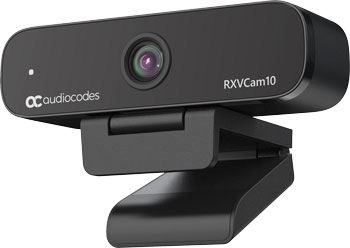
Choosing the Correct Field of View of Video Conferencing
When shopping for a camera for video calls, field of view is an important consideration.
For a digital camera, field of view is determined by the relation between the focal length of a lens and the camera sensor. The field of view is given as an angle degree from the camera. A 90° field of view means the camera can display a 90° slice of the scene in front of it. Field of view is given as diagonal, horizontal, or vertical. Those terms indicate how the angle degree is calculated: from the corners of the image (diagonal), from the left and right sides (horizontal), or from the top and bottom sides (vertical).
Whew, that’s complicated!
The thing to know is that the wider the field of view, the more you can see on the sides. Think of your smartphone and how you have to use different cameras for different situations: it’s the same deal with video conferencing cameras and webcams.
Most webcams have a field of view that’s optimized for making a single face look good. That means, typically, a narrower field of view, because it doesn’t need to show anything on the sides. (A narrower field of view also makes faces look slimmer, which we can all appreciate!)
Video conferencing cameras, however, come with a range of options to suit different situations.
In smaller spaces where people will sit closer to the camera, having a wide-angle lens is important. By wide-angle, we mean roughly a 100°+ diagonal field of view. You don’t want to people to have to smush together to get in frame, do you?
In larger spaces, a narrower field of view is preferable, because the camera needs the extra reach.
Field of view is also affected by zoom. But zoom is a big topic, so let’s look at that separately.
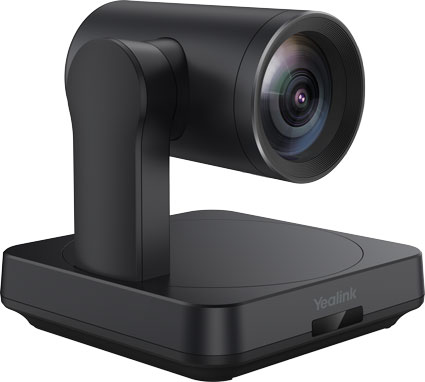
Optical Zoom Is Better Than Digital Zoom
There are two types of camera zoom to know about: optical zoom and digital zoom. Many video conferencing cameras offer optical zoom, while both will likely offer some form of digital zoom.
When you can adjust the focal length of a lens physically, that’s called optical zoom. When you adjust the focal length computationally, that’s called digital zoom. The two can be combined by using digital zoom on top of optical zoom. This is often referred to as total zoom and is derived by multiplying optical zoom by digital zoom.
For the best picture quality, optical zoom is the best choice because it’s lossless. The field of view narrows as the camera is zoomed in, which helps with reach to pick out individual faces effectively.
Digital zoom is, essentially, cropping the picture and blowing up the cropped picture, which means it’s necessarily lossy. The field of view actually isn’t changing, because the camera is cropping, not adjust focal length.
The problem is that video conferencing cameras with optical zoom tend to be more expensive, because the lenses are much more complicated to manufacture.
A camera that can zoom is important to get the most effective shot possible. Remember, we’re talking about professional video conferencing here. You might need to zoom in on a speaker’s face or frame the group of participants more closely so you’re not showing a bunch of wasted space. Zoom is particularly important as the conference room spaces get larger, because people will be sitting farther away.
So look for optical zoom when you can.
By the way, if you ever see the term “ePTZ” (electronic pan-tilt-zoom), that can be thought of as the equivalent of digital zoom: it “pans” and “tilts” by cropping the picture to focus on off-center portions of picture.
Here’s an analogy for you — optical zoom : digital zoom :: PTZ : ePTZ. (Is that too nerdy? Let’s move on.)

Multi-Camera Conference Rooms
Sometimes one camera isn’t enough. If you have to setup a conference room for large groups of people, it can be a good idea to use multiple video conferencing cameras.
That might mean a camera on one side of the display and one on the other: one to capture the right side of the room, the other for the left. It might mean using one dedicated PTZ camera for picking out individual faces and one wide-angle camera for whole group coverage.
To the best of our knowledge, multi-webcam rooms aren’t a thing. So multi-camera video conferencing spaces require video conferencing cameras. They also require system support, which might mean using an AV switch like Yealink AVHub to manage the feeds.
Looking for an example? Check out our blog, “How to Setup a Multi-Camera Zoom Rooms Video Conferencing System.”
For a professional video conferencing ecosystem in extra-large conference rooms, look for multi-camera solutions.

What About a Video Bar Instead of Webcam?
To finish, we wanted to say a couple of words about Video Bars. Video bars look like the sound bar you use with your TV at home, except with a camera in the middle of them.
A video bar is a professional video conferencing device that combines a video conferencing camera, speaker, and microphone in one unit. They might also be codecs that run the video conferencing software, too.
The advantage of a video bar is simplicity: it’s an all-in-one solution. You don’t need to worry about getting separate cameras, speakers, microphones, and so on.
Video bars have pretty advanced cameras now. For example, the new Yealink SmartVision 40 uses two cameras with 48 MP sensors. It stitches together the video feeds from these dual cameras to provide exceptionally detailed 4K Ultra HD video. Yealink A30 has one wide-angle camera and one telephoto camera, which offers 3.5x optical zoom, so you get a multi-camera setup on top of its stereo speakers, 8-element microphone array, and Android-based codec.
There are video bar options for huddle rooms up to large conference rooms. So when shopping for a professional video conferencing camera, be sure to look into video bars, too!
For more on video bars, check out our clear, detailed Video Bars Buyer’s Guide.

